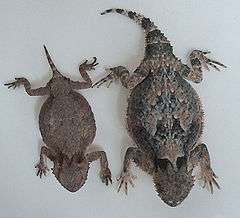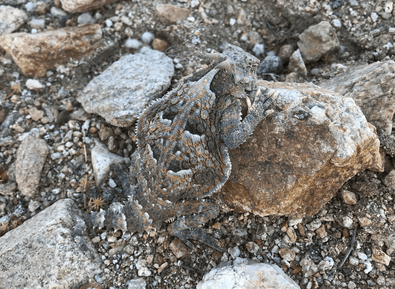Horned lizard
Horned lizards (Phrynosoma), also known as horny toads or horntoads, are a genus of North American lizards and the type genus of the family Phrynosomatidae. The common names refer directly to their flattened, rounded bodies and blunt snouts.
| Horned lizard | |
|---|---|
 | |
| Regal horned lizard | |
| Scientific classification | |
| Kingdom: | Animalia |
| Phylum: | Chordata |
| Class: | Reptilia |
| Order: | Squamata |
| Suborder: | Iguania |
| Family: | Phrynosomatidae |
| Genus: | Phrynosoma Wiegmann, 1828 |
| Species | |
|
See text | |
The genus name Phrynosoma means "toad-bodied". In common with true toads (family Bufonidae), horned lizards tend to move sluggishly, often remain motionless, and rely on their remarkable camouflage to avoid detection by predators. They are adapted to arid or semiarid areas. The spines on the lizard's back and sides are modified reptile scales, which prevent water loss through the skin, whereas the horns on the head are true horns (i.e. they have a bony core). Of the 22 species of horned lizards, 15 are native to the United States. The largest-bodied and most widely distributed of the US species is the Texas horned lizard.
Defenses

Horned lizards use a variety of means to avoid predation. Their coloration generally serves as camouflage. When threatened, their first defense is to remain still to avoid detection. If approached too closely, they generally run in short bursts and stop abruptly to confuse the predator's visual acuity. If this fails, they puff up their bodies to cause them to appear more horned and larger, so that they are more difficult to swallow.[1]
At least eight species (P. asio, P. cornutum, P. coronatum, P. ditmarsi, P. hernandesi, P. orbiculare, P. solare, and P. taurus) are also able to squirt an aimed stream of blood from the corners of the eyes for a distance up to 5 ft (1.5 m).[2][3][4][5] They do this by restricting the blood flow leaving the head, thereby increasing blood pressure and rupturing tiny vessels around the eyelids. The blood not only confuses predators, but also tastes foul to canine and feline predators. It appears to have no effect against predatory birds. Only three closely related species (P. mcallii, P. modestum, and P. platyrhinos) are certainly known to be unable to squirt blood.[3]
While previous thought held that compounds were added to the blood from glands in the ocular sinus cavity, current research has shown that the chemical compounds that make up the defense are already in the circulating blood.[3][4] It is possible that their diet of large quantities of venomous harvester ants could be a factor; however, the origin and structure of the chemicals responsible are still unknown. The blood-squirting mechanism increases survival after contact with canine predators;[4] the trait may provide an evolutionary advantage. Ocular autohemorrhaging has also been documented in other lizards,[6] which suggests blood-squirting could have evolved from a less extreme defense in the ancestral branch of the genus. Recent phylogenic research supports this claim, so the species incapable of squirting blood apparently have lost the adaptation for reasons yet unstudied.[7]
To avoid being picked up by the head or neck, a horned lizard ducks or elevates its head and orients its cranial horns straight up, or back. If a predator tries to take it by the body, the lizard drives that side of its body down into the ground so the predator cannot easily get its lower jaw underneath.
Population decline
Horned lizard populations continue to disappear throughout the Southwest despite protective legislation. The Texas horned lizard has disappeared from almost half of its geographic range. Population declines are attributed to loss of habitat, human eradication of the ant populations upon which the lizards prey, displacement of native ant populations by invading fire ants (aided by synergistic effects of native ant eradication), and predation by domestic dogs and cats.[8]
In 2014, the Center for Biological Diversity in Tucson petitioned the Oklahoma Department of Wildlife Conservation to have the Texas horned lizard put on the endangered species list due to the massive declines of its population in Oklahoma, where it was once plentiful. The center said it may later seek protection for the animal on a federal level; it also said that reptiles in general are dying off at up to 10,000 times their historic extinction rate, greatly due to human influences.[9]
Species and subspecies
These 22 species are recognized as being valid, three species of which have recognized subspecies:[10]
- Giant horned lizard, Phrynosoma asio Cope, 1864
- Phrynosoma bauri Montanucci, 2015
- San Diego horned lizard or Blainville's horned lizard Phrynosoma blainvillii Gray, 1839
- Short-tailed horned lizard, Phrynosoma braconnieri A.H.A. Duméril, 1870
- Phrynosoma brevirostris (Girard, 1858)
- Cedros Island horned lizard, Phrynosoma cerroense Stejneger, 1893
- Texas horned lizard, Phrynosoma cornutum (Harlan, 1825)
- Coast horned lizard, Phrynosoma coronatum (Blainville, 1835)
- Cape horned lizard, P. c. coronatum (Blainville, 1835)
- California horned lizard, P. c. frontale Van Denburgh, 1894
- Central peninsular horned lizard, P. c. jamesi Schmidt, 1922
- Phrynosoma diminutum Montanucci, 2015
- Ditmars' horned lizard or rock horned lizard, Phrynosoma ditmarsi Stejneger, 1906
- Pygmy short-horned lizard, Phrynosoma douglasii (Bell, 1828)
- Phrynosoma goodei Stejneger, 1893
- Greater short-horned lizard, Phrynosoma hernandesi Girard, 1858
- Flat-tail horned lizard, Phrynosoma mcallii (Hallowell, 1852)
- Roundtail horned lizard, Phrynosoma modestum Girard, 1852

- Mexican Plateau horned lizard or Chihuahua Desert horned lizard, Phrynosoma orbiculare (Linnaeus, 1758)
- P. o. bradti Horowitz, 1955
- P. o. cortezii (A.H.A. Duméril & Bocourt, 1870)
- P. o. dugesii (A.H.A. Duméril & Bocourt, 1870)
- P. o. orbiculare (Linnaeus, 1758)
- P. o. orientale Horowitz, 1955
- Phrynosoma ornatissimum (Girard, 1858)
- Desert horned lizard, Phrynosoma platyrhinos Girard, 1852
- Southern desert horned lizard, P. p. calidiarum (Cope, 1896)
- Northern desert horned lizard, P. p. platyrhinos Girard, 1852
- Phrynosoma sherbrookei Nieto-Montes de Oca et al., 2014
- Regal horned lizard, Phrynosoma solare Gray, 1845
- Mexican horned lizard, Phrynosoma taurus Dugès, 1873
- Gulf Coast horned lizard, Phrynosoma wigginsi Montanucci, 2004
Nota bene: In the above list, a binomial authority or trinomial authority in parentheses indicates that the species or subspecies was originally described in a genus other than Phrynosoma.
Horned lizard (Phrynosoma) gallery
.jpg) Blainville's horned lizard (P. blainvillii)
Blainville's horned lizard (P. blainvillii) Short-tailed horned lizard (P. braconnieri), Oaxaca, Mexico (20 May 2013).
Short-tailed horned lizard (P. braconnieri), Oaxaca, Mexico (20 May 2013).%2C_Armstrong_County%2C_Texas%2C_USA_(28_April_2013).jpg) Texas horned lizard (P. cornutum), Armstrong County, Texas, USA (28 April 2013)
Texas horned lizard (P. cornutum), Armstrong County, Texas, USA (28 April 2013)_(6-14-08)_cerro_alto_north_ridge%2C_slo_co%2C_ca_-01_(2579107136).jpg) Coast horned lizard (P. coronatum), San Luis Obispo County, California, USA (June 14, 2008)
Coast horned lizard (P. coronatum), San Luis Obispo County, California, USA (June 14, 2008)_(3481418737).jpg) Coast horned lizard (P. coronatum) (25 April 2009)
Coast horned lizard (P. coronatum) (25 April 2009).jpg) Greater short-horned lizard (P. douglassi brevirostre), Sweetwater County, Wyoming, USA (15 June 2016).
Greater short-horned lizard (P. douglassi brevirostre), Sweetwater County, Wyoming, USA (15 June 2016).- Pygmy short-horned lizard (P. douglasii), Washington, USA (5 June 2014)
%2C_Culberson_County%2C_Texas%2C_USA_(19_May_2018).jpg) Mountain short-horned lizard (P. hernandesi), Culberson County, Texas, USA (19 May 2018)
Mountain short-horned lizard (P. hernandesi), Culberson County, Texas, USA (19 May 2018).jpg) Flat-tailed horned lizard (P. mcallii) (9 November 2010)
Flat-tailed horned lizard (P. mcallii) (9 November 2010)%2C_Municipality_of_Tula%2C_Tamaulipas%2C_Mexico_(15_August_2004).jpg) Round-tail horned lizard (P. modestum), Municipality of Tula, Tamaulipas, Mexico (15 August 2004)
Round-tail horned lizard (P. modestum), Municipality of Tula, Tamaulipas, Mexico (15 August 2004)%2C_Municipality_of_Miquihuana%2C_Tamaulipas%2C_Mexico_(24_September_2009).jpg) Mountain horned lizard (P. orbiculare orientale), Municipality of Miquihuana, Tamaulipas, Mexico (24 September 2009)
Mountain horned lizard (P. orbiculare orientale), Municipality of Miquihuana, Tamaulipas, Mexico (24 September 2009) Desert horned lizard (P. platyrhinos), San Bernardino County, California, USA (9 July 2019)
Desert horned lizard (P. platyrhinos), San Bernardino County, California, USA (9 July 2019) Regal horned lizard (P. solare), Apache Junction, Arizona, USA (25 March 2007)
Regal horned lizard (P. solare), Apache Junction, Arizona, USA (25 March 2007)
Symbol
The genus of horned lizards is the official state reptile of Wyoming.[11] Texas designated the Texas horned lizard (Phrynosoma cornutum) as the official state reptile in 1993[12] and the "TCU Horned Frog" is the mascot of Texas Christian University in Fort Worth, Texas. TCU is the only known athletic team with the horned lizard as a mascot.
 The TCU mascot is commonly known as Super frog to TCU fans and students. He is usually present at TCU sporting events.
The TCU mascot is commonly known as Super frog to TCU fans and students. He is usually present at TCU sporting events. Horned lizard on a necktie at El Paso, Texas, in 1940
Horned lizard on a necktie at El Paso, Texas, in 1940
References
- Winton, W. M. (1916-10-24). "Habits and Behavior of the Texas Horned Lizard, Phrynosoma cornutum, Harlan. I". Copeia. JSTOR (36): 81–84. doi:10.2307/1436504. ISSN 0045-8511. JSTOR 1436504.
- Middendorf III, G.A.; Sherbrooke, W.C.; Braun, E.J. (2001). "Comparison of Blood Squirted from the Circumorbital Sinus and Systemic Blood in a Horned Lizard, Phrynosoma cornutum". The Southwestern Naturalist. 46 (3): 384–387. doi:10.2307/3672440. JSTOR 3672440.
- Sherbrooke, W.C.; Middendorf III, G.A. (2001). "Blood-Squirting Variability in Horned Lizards (Phrynosoma)" (PDF). Copeia. 2001 (4): 1114–1122. doi:10.1643/0045-8511(2001)001[1114:BSVIHL]2.0.CO;2. JSTOR 1448403.
- Sherbrooke, W.C.; Middendorf III, G.A. (2004). "Responses of Kit Foxes (Vulpes macrotis) to Antipredator Blood-Squirting and Blood of Texas Horned Lizards (Phrynosoma cornutum)". Copeia. 2004 (3): 652–658. doi:10.1643/CH-03-157R1. JSTOR 1448486.
- Hodges, W.L. (2004). "Defensive blood squirting in Phrynosoma ditmarsi and a high rate of human-induced blood squirting in Phrynosoma asio". The Southwestern Naturalist. 49 (2): 267–270. doi:10.1894/0038-4909(2004)049<0267:DBSIPD>2.0.CO;2. JSTOR 3672697.
- Sherbrooke, W. C. (2000). "Sceloporus jarrovii (Yarrow's spiny lizard) Ocular Sinus Bleeding". Herpetological Review. 31: 243.
- Leache, A. D.; J. A. McGuire (2006). "Phylogenetic relationships of hores lizards (Phrynosoma) based on nuclear and mitochondrial data: evidence for a misleading mitochondrial gene tree" (PDF). Molecular Phylogenetics and Evolution. 39 (3): 628–644. doi:10.1016/j.ympev.2005.12.016. PMID 16488160.
- Pianka, Eric; Hodges, Wendy. "Horned Lizards, Part 2". uts.cc.utexas.edu. University of Texas. Archived from the original on April 26, 2015. Retrieved March 1, 2015.
- Godfrey, Ed (December 20, 2014). "Center for Biological Diversity wants Texas horned lizard declared an endangered species in Oklahoma". The Daily Oklahoman. Retrieved November 5, 2018.
- "Phrynosoma ". The Reptile Database. www.reptile-database.org.
- "State symbols". Wyoming Secretary of State's Office. 2011. Archived from the original on September 6, 2011. Retrieved January 22, 2011.
- Texas Horned Lizard. State Symbols USA. Retrieved on 2016-10-25.
External links
| Wikispecies has information related to Phrynosoma |
| Wikimedia Commons has media related to Phrynosoma. |